AMD Ryzen Threadripper 7980X & 7970X Review: Revived HEDT Brings More Cores of Zen 4
by Gavin Bonshor on November 20, 2023 9:00 AM EST- Posted in
- CPUs
- AMD
- HEDT
- ThreadRipper
- Zen 4
- Threadripper 7000
- TRX50
TR 7000 vs. Intel: Power and Compile
Our previous sets of ‘office’ benchmarks have often been a mix of science and synthetics, so this time, we wanted to keep our office and productivity section purely based on real-world performance. We've also incorporated our power testing into this section. Given the nature and target market of the Ryzen Threadripper 7000 series, we've opted to focus on tasks such as compiling.
We are using DDR5-5200 RDIMM memory on the Ryzen Threadripper 7980X and 7970X as per JEDEC specifications. For Intel's Xeon W9-3495X, we are using DDR5-4800 RDIMM memory as per Intel's JEDEC specifications. It should be noted that both platforms are run with their full allocation of memory channels, e.g., TR7000 in 4-channel and Sapphire Rapids in 8-channel.
Below are the settings we have used for each platform:
- DDR5-5200 RDIMM - AMD Threadripper 7000
- DDR5-4800 RDIMM - Intel Xeon Sapphire Rapids WS
- DDR5-5600B CL46 - Intel 14th Gen
- DDR5-5200 CL44 - Ryzen 7000
Power
The nature of reporting processor power consumption has become, in part, a bit of a nightmare. Historically the peak power consumption of a processor, as purchased, is given by its Thermal Design Power (TDP, or PL1). For many markets, such as embedded processors, that value of TDP still signifies the peak power consumption. For the processors we test at AnandTech, either desktop, notebook, or enterprise, this is not always the case.
Modern high-performance processors implement a feature called Turbo. This allows, usually for a limited time, a processor to go beyond its rated frequency. Exactly how far the processor goes depends on a few factors, such as the Turbo Power Limit (PL2), whether the peak frequency is hard coded, the thermals, and the power delivery. Turbo can sometimes be very aggressive, allowing power values 2.5x above the rated TDP.
AMD and Intel have different definitions for TDP that are, broadly speaking, applied the same. The difference comes from turbo modes, turbo limits, turbo budgets, and how the processors manage that power balance. These topics are 10000-12000 word articles in their own right, and we’ve got a few articles worth reading on the topic.
- Why Intel Processors Draw More Power Than Expected: TDP and Turbo Explained
- Talking TDP, Turbo and Overclocking: An Interview with Intel Fellow Guy Therien
- Reaching for Turbo: Aligning Perception with AMD’s Frequency Metrics
- Intel’s TDP Shenanigans Hurts Everyone
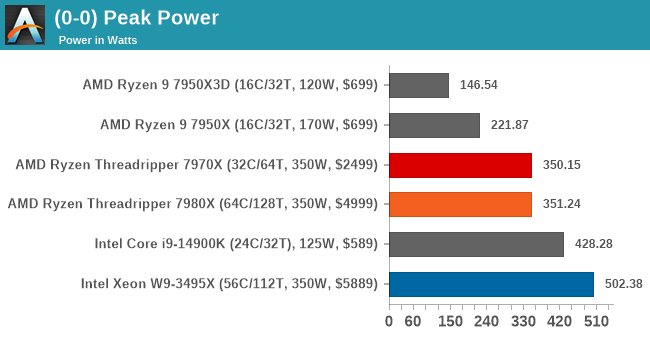
Looking at the max power we observed on the AMD Ryzen Threadripper 7980X and 7970X processors, we can see they hit and don't go robustly above their rated TDPs of 350 W. In contrast, the Intel Xeon W9-3495X peaked at a huge 502 W, well above the rated 350 W TDP. Compared to the desktop processors we've added to the data set, both Threadripper 7000 series processors are also considerably below the Intel Core i9-14900K.
Moving onto a deeper look at how the AMD Ryzen Threadripper 7980X compares to the Intel Xeon W9-3495X in Prime95 with Small FFTs, we can see that Intel's Sapphire Rapids WS option draws considerably more power. Despite having eight more cores than the W9-3495X, the Threadripper 7980X runs consistently within AMD's designated TDP of 350W; this is the TDP for all three AMD Ryzen Threadripper 7000 series SKUs. As we've highlighted in our desktop reviews of the Ryzen 9 7950X and Ryzen 9 7950X3D processors, we know AMD's Zen 4 core doesn't only deliver in performance, but it's a highly efficient core, too.
Compile/Database
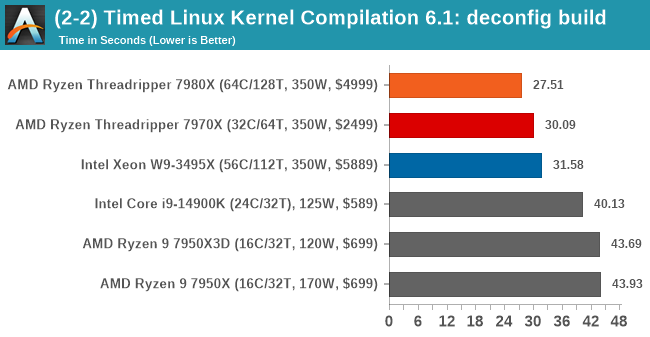
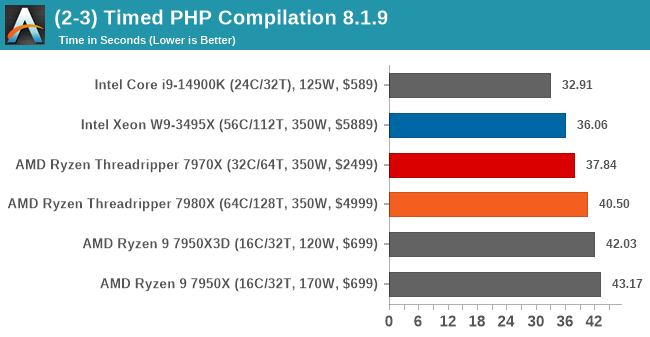
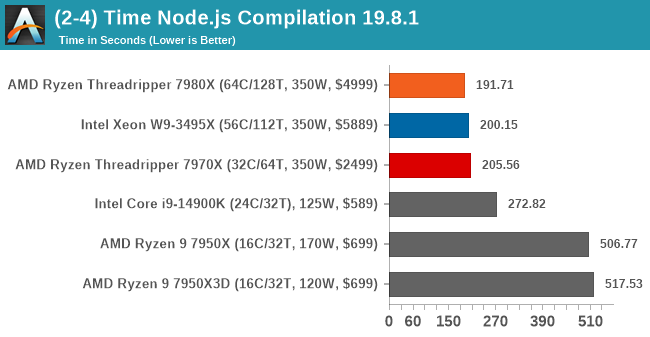
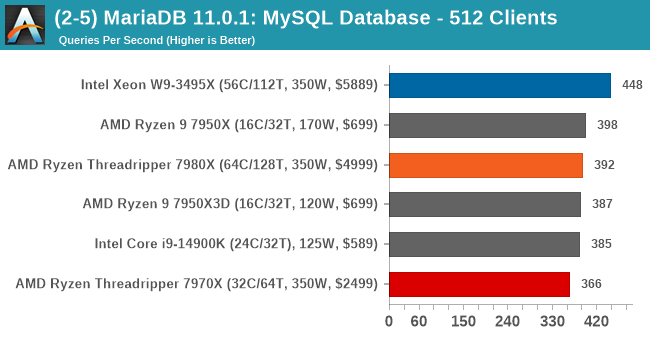
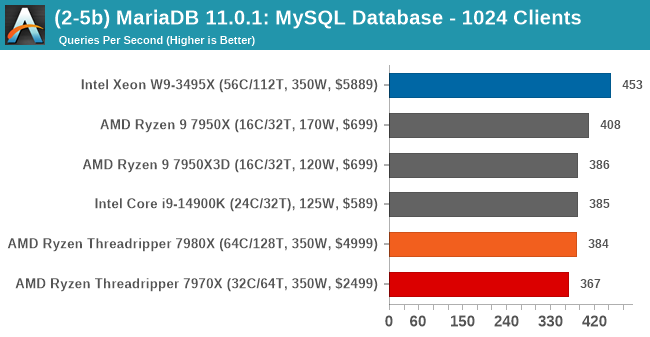
In our timed compilation benchmarks, including Linux Kernel, PHP, and Node.js, we can see that the Threadripper 7980X and 7970X perform well for the most part. In larger compilations such as Node.js, there's a significant advantage to having a higher core/thread count. Intel's Xeon W9-3495X beats all the chips we tested convincingly in the MariaDB MySQL database benchmark, with the flagship desktop chips also performing well here.


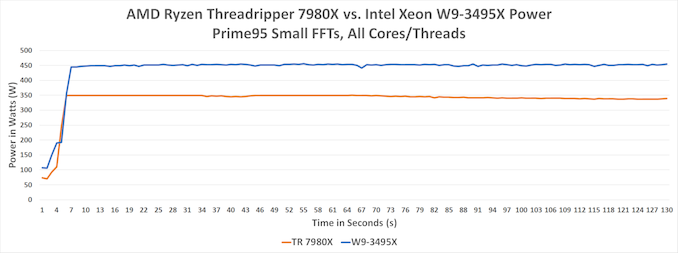








66 Comments
View All Comments
thestryker - Monday, November 20, 2023 - link
Forgot to add: these are just the lower SKU workstation parts not a resurrection of HEDTwujj123456 - Monday, November 20, 2023 - link
> the AMD Ryzen Threadripper 7980X ($4999), despite having eight fewer cores than the W9-3495X ($5889), half the memory channels (4 vs. 8) and being ultimately cheaper, it is the better option.Am I reading it wrong? 7980X has eight more cores than W9-3495X not fewer. Don't think it changes the conclusion though.
rUmX - Tuesday, November 21, 2023 - link
You're rightGavin Bonshor - Tuesday, November 21, 2023 - link
Thanks for highlighting that obvious error, edited!bernstein - Monday, November 20, 2023 - link
It remains true, what has been true for every threadripper: if your software allows for computing on more than one node, using 5-10 ryzen servers for the same money gives you more performance, redundancy, more io-bandwith & for many usecases even more total ram.vfridman - Monday, November 20, 2023 - link
There is a lot of so called "professional" use cases that require a lot of RAM on a single machine. It often possible to split calculations across a cluster of machines, but not so with RAM.quorm - Monday, November 20, 2023 - link
A nice increase in performance, but seems like almost everyone would be better off with either desktop ryzen or pro/epyc.Thunder 57 - Monday, November 20, 2023 - link
You should either use bar graphs that show the 14900K's performance when limited to 125W, or you should just change the graphs and list the 14900K as 428W.AMD doesn't get a pass either but at least they are more honest. With these new Threadrippers they are actually spot on. Meanwhile the "350W" Xeon uses just over 500W. At the very least maybe include some efficiency charts?
thestryker - Monday, November 20, 2023 - link
Not that the power consumption is good, but these represent the absolute maximum power draw number seen they do not represent workload power draw. If they were to pick "real" power numbers they would have to measure power consumption for every single test and show that.Oxford Guy - Tuesday, November 21, 2023 - link
Deceptive power usage needs to be stopped.